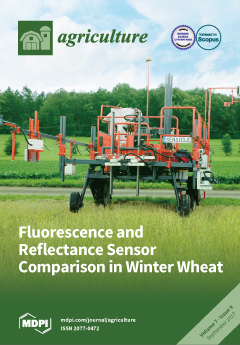Conventional Maize Monoculture (MM), a dominant Cropping System in South-Western France, is now questioned for environmental reasons (nitrate leaching, pesticide use and excessive irrigation). Three low-input Cropping Systems (CS) using diverse weeding strategies (MM
LI, a Low-Input MM implementing ploughing, a combination
[...] Read more.
Conventional Maize Monoculture (MM), a dominant Cropping System in South-Western France, is now questioned for environmental reasons (nitrate leaching, pesticide use and excessive irrigation). Three low-input Cropping Systems (CS) using diverse weeding strategies (MM
LI, a Low-Input MM implementing ploughing, a combination of on-row spraying and in-between row cultivation and cover crops; MM
CT, Conservation Tillage MM implementing chemical control and cover crops; Maize-MSW, maize managed similar to MM
LI but rotated with soybean & wheat) were compared to a reference system (MM
Conv, a conventional MM with tillage and a high quantity of inputs). Potential of Infestation of weeds (PI), weed biomass and crop production of these CS were compared during the first five years after their establishment. Yields were also assessed in weed-free zones hand-weeded weekly in 2014 and 2015. Weed communities did not drastically differ among CS. PI and weed biomass were higher in MM
CT, especially for
Echinochloa crus-galli (L.) P.Beauv. and were comparable between MM
Conv, MM
LI and Maize-MSW. Analysis of covariance between CS and weed biomass did not reveal a significant interaction, suggesting that weed biomass affected yield similarly among the CS. Comparison between weedy and weed-free zones suggested that weeds present at maize maturity negatively affected yields to the same extent for all four CS, despite having different weed biomasses. Grain yields in MM
Conv (11.3 ± 1.1 t ha
−1) and MM
LI (10.6 ± 2.3 t ha
−1) were similar and higher than in MM
CT (8.2 ± 1.9 t ha
−1. Similar yields, weed biomasses and PI suggest that MM
LI and Maize-MSW are interesting alternatives to conventional MM in terms of weed control and maize productivity and should be transferred to farmers to test their feasibility under wider, farm-scale conditions.
Full article





